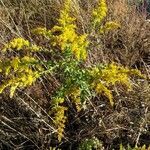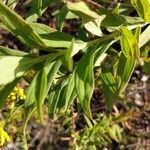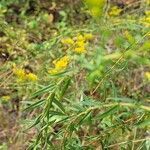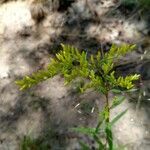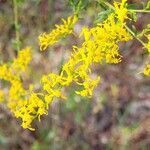Plants 60–120 cm; caudices short, stout. Stems 1–5+, erect to arching, puberulent in arrays and in lines proximal to leaf bases or uniformly. Leaves usually anise-scented when crushed ; basal and proximal usually withering by flowering, tapering to broadly winged petioles, blades oblanceolate, margins entire, short-strigillose, faces glabrous or short scabroso-strigillose along main nerves; mid and distal cauline sessile, blades lanceolate to linear-lanceolate or narrowly ovate, 30–110 × 8–20 mm, much reduced distally, bases rounded, margins entire, midnerves prominent, sometimes scabroso-strigillose basally to much of length, apices acute, faces glabrous, finely translucent gland-dotted. Heads (20–)75–350, in paniculiform arrays, openly secund, pyramidal, proximal to mid branches ascending to spreading, recurved, secund, 3–18 cm. Peduncles thin, 2–8 mm, glabrate to finely puberulent, glabrous strips proximal to few linear-lanceolate bracteoles. Involucres narrowly campanulate, 3.5–5 mm. Phyllaries in 3–4 series, strongly unequal, yellowish, acute, glabrous; outer narrowly ovate to lanceolate, inner lanceolate to linear-lanceolate. Ray florets 3–4(–6); laminae 1.4–2.5 × 0.4–0.9 mm. Disc florets 3–5; corollas 2.7–3.5 mm, lobes 0.5–1.3 mm. Cypselae (obconic) 1.4–2.3 mm, strigose to glabrate; pappi 2.4–3 mm.
More
Stems 6–16 dm from a short, stout caudex, rough-puberulent in the infl and in lines decurrent from at least the upper lf-bases; lvs chiefly cauline, sessile, entire, glabrous except for the scabrous margins, finely translucent-punctate, anise-scented when bruised (rarely inodorous), not prominently veined, the main ones 4–11 × 0.5–1.5(–2) cm, 5–15 times as long as wide; infl paniculiform, with recurved-secund branches; invol 3.5–5 mm, its bracts slender, acute, yellowish; rays 3–5(6), fairly showy; disk-fls 3–5; achenes short-hairy or subglabrous; 2n=18. Dry, open woods, especially in sandy soil; Mass., N.H., and Vt. to s. O. and s. Mo., s. to Fla. and Tex. Ours is var. odora.
Sandy and clay soils, dry open woods, pine barrens, damp peaty pine woods, sand hills, edges of oak and pine woods, disturbed areas, roadside embankments from sea level to 700 metres.
More
It is a temperate plant. It suits hardiness zones 3-9.
